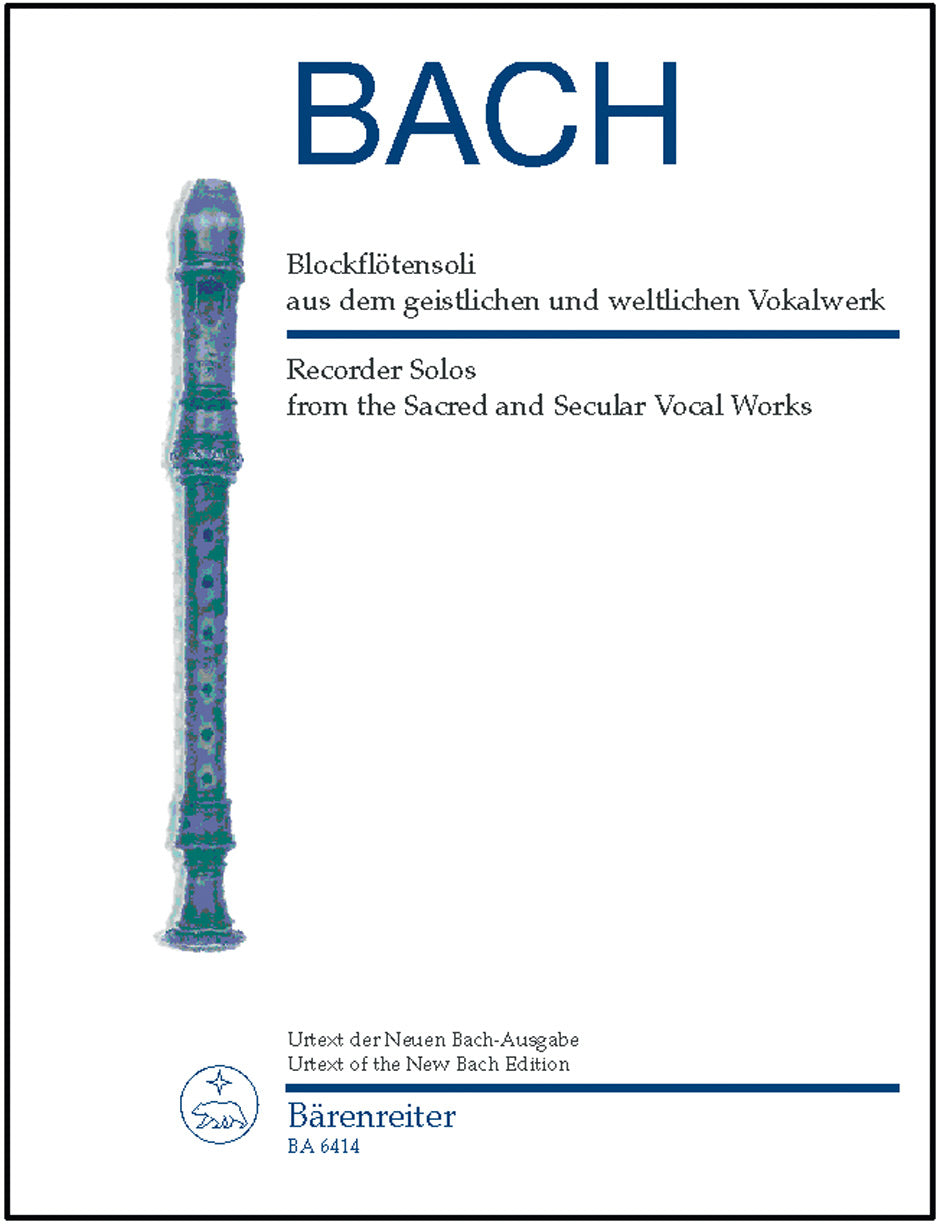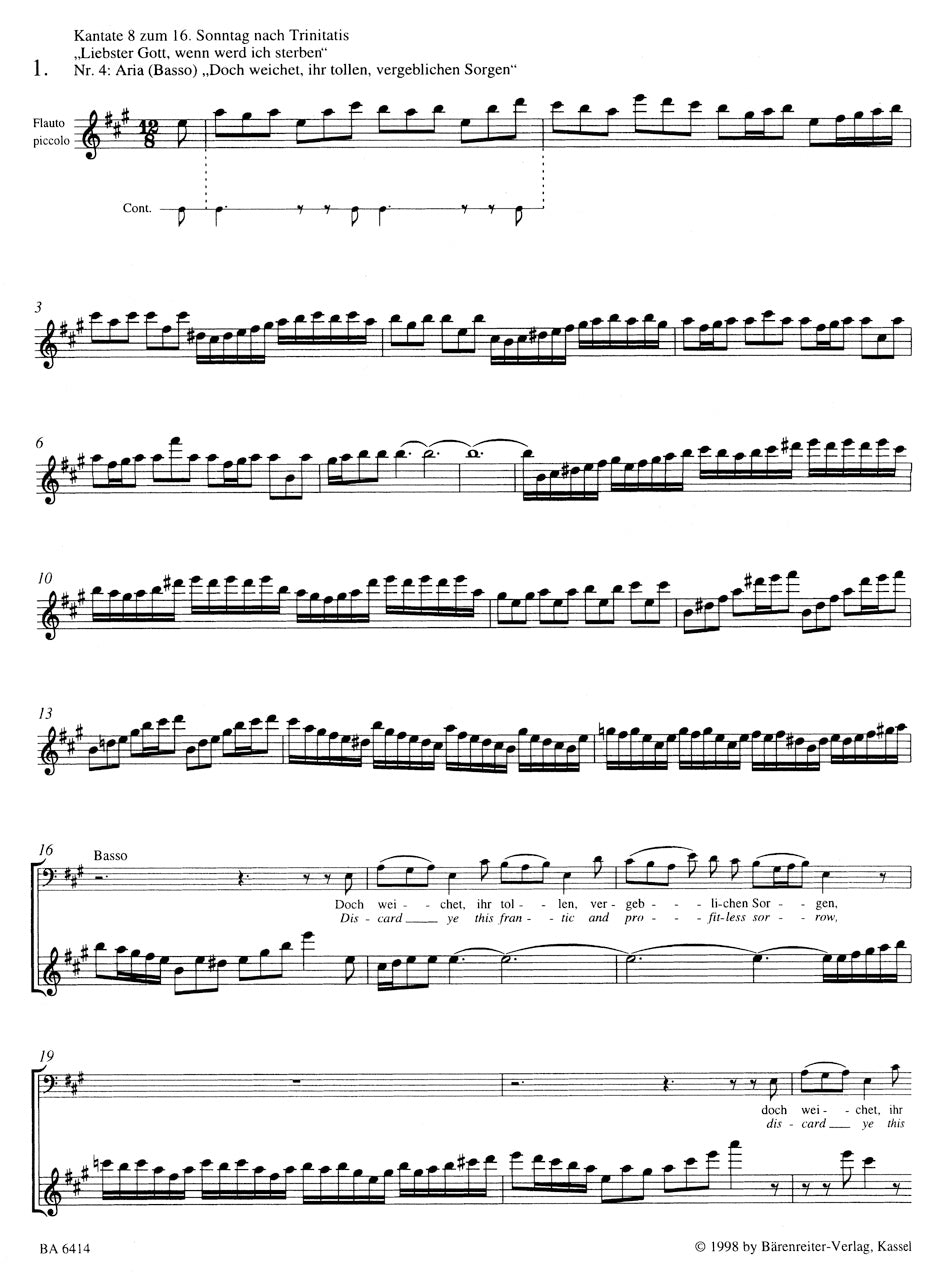Bach: Recorder Solos from the Sacred and Secular Vocal Works
16 pieces for 1-3 recorders
Expected to ship in about a week.
- Composer: Johann Sebastian Bach (1685-1750)
- Format: Performance Score
- Instrumentation: Recorder Ensemble
- Work Language: German
- ISMN:
- Size: 9.1 x 11.8 inches
- Urtext / Critical Edition
Description
This volume presents, for the first time, arias from the Easter Oratorio, the Magnificat in E-flat Major, sacred cantatas and the secular cantata BWV 208 of Johann Sebastian Bach that contain obbligato parts for one, two or three recorders. The musical text has been adopted from the "Urtext" of the New Bach Edition.
Music and words are inseparable in Bach's works. Therefore, as an aid to the interpretation of these flute solos, our richly annotated collection offers not only flute part but also the complete vocal part for each movement. in this way, the edition not only represents a novel form of orchestral studies, it also opens up an important area of the flute repertoire.
- A comprehensive introduction offers an overview of the Recorder in Bach's Vocal Music as well as detailed information on each of the movements.
Contents:
Bass-Arie "Doch weichet, ihr tollen, vergeblichen Sorgen" aus Kantate 8 "Liebster Gott, wann werd ich sterben"
Tenor-Arie "Meine Seufzer, meine Tränen" (2 Flöten) aus Kantate 13 "Meine Seufzer, meine Tränen"
Bass-Arie "Ächzen and erbärmlich Weinen" (2 Flöten unisono) aus Kantate 13
Sopran-Arie "Mein Seelenschatz istGottes Wort" (2 Flöten unisono) aus Kantate 18 "Gleichwie der Regen and der Schnee vom Himmel fällt"
Sopran-Arie "Öffne meinen schlechten Liedern" (3 Flöten) aus Kantate 25 "Es ist nichts Gesundes an meinem Leibe"
Sopran-Arie "Höchster, was ich habe" (2 Flöten unisono) aus Kantate 39 "Brich dem Hungrigen dein Brot
Alt-Arie "Doch Jesus will auch bei der Strafe" (2 Flöten) aus Kantate 46 "Schauet doch and sehet"
Alt-Arie "Kein Arzt ist außer dir zu finden" aus Kantate 103 "Ihr werdet weinen and heulen"
Tenor-Solo"Ach Herr! Herr, lehre uns bedenken" and Bass-Solo "Bestelle dein Haus" (2 Flöten unisono) aus Kantate 106 "Gottes Zeit ist die allerbeste Zeit"
Alt-Arie "Die Obrigkeit ist Gottes Gabe" (2 Flöten unisono) aus Kantate 119 "Preise, Jerusalem, den Herrn
Sopran-Arie "Stein, der über alle Schätze" aus Kantate 152 "Tritt auf die Glaubensbahn"
Tenor-Recitativ "Er rufet seinen Schafen mit Namen" and Alt-Arie "Komm, leite mich" (3 Flöten) aus
Kantate 175 "Er rufet seinen Schafen mit Namen"
Alt-Arie "Leget euch dem Heiland unter" aus Kantate 182 "Himmelskönig, sei willkommen"
Tenor-Arie"Sanfte soll mein Todeskummer" (2 Flöten) aus Oster-Oratorium BWV 249
Alt-Arie "Esurientes" (2 Flöten) aus Magnificat E-flat Major BEV 243a
Sopran-Arie "Schafe können sicher weiden" (2 Flöten) aus Kantate 208 "Was mir behagt, ist nur die muntre Jagd"
Publishers use a lot of words to describe what they sell, and we know it can be confusing. We've tried to be as clear as possible to make sure you get exactly what you are looking for. Below are descriptions of the terms that we use to describe the various formats that music often comes in.
Choral Score
A score for vocalists that only contains the vocal lines. The instrumental parts are not there for reference. Generally, cheaper than a vocal score and requires multiple copies for purchase.
Facsimile
Reproductions of the original hand-written scores from the composer.
Full Score
For ensemble music, this indicates that the edition contains all parts on a single system (there are not separate parts for each player). In larger ensembles, this is for the conductor.
Hardcover
Hardbound. Generally either linen-covered or half-leather.
Orchestral Parts
Similar to a wind set, this is a collection of parts. In the case of strings, the numbers listed are the number of copies included, though generally these are available individually (often with minimum quantities required).
Paperback
When publishers offer multiple bindings (e.g. hardcover) or study scores, this is the "standard" version. If you're planning to play the music, this is probably what you want.
Performance / Playing Score
A score of the music containing all parts on one system, intended for players to share. There are not separate parts for each player.
Set of Parts
For ensemble music, this indicates that there are separate individual parts for each player.
Solo Part with Piano Reduction
For solo pieces with orchestra, this is a version that contains a piano reduction of the orchestra parts. For piano pieces, two copies are typically needed for performance.
Study Score
A small (think choral size) copy of the complete score meant for studying, and not playing. They make great add-ons when learning concertos and small chamber works.
Vocal Score
A score prepared for vocalists that includes the piano/organ part or a reduction of the instrumental parts.
Wind Set
For orchestral music, this is a collection of wind and percussion parts. The specific quantities of each instrument are notated.
With Audio
In addition to the printed music, the edition contains recordings of the pieces. This may be an included CD, or access to files on the internet.
With / Without Fingering (Markings)
Some publishers prepare two copies - a pure Urtext edition that includes no fingering (or bowing) suggestions and a lightly edited version that includes a minimal number of editorial markings.




